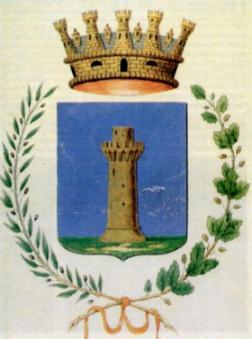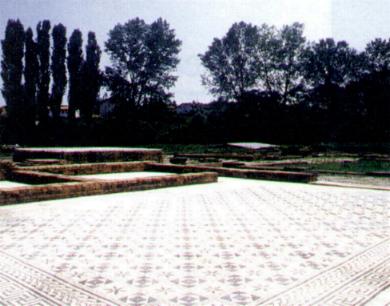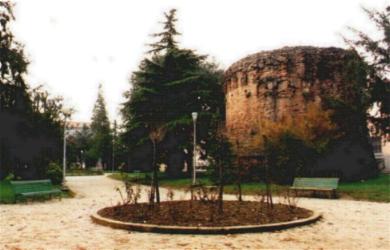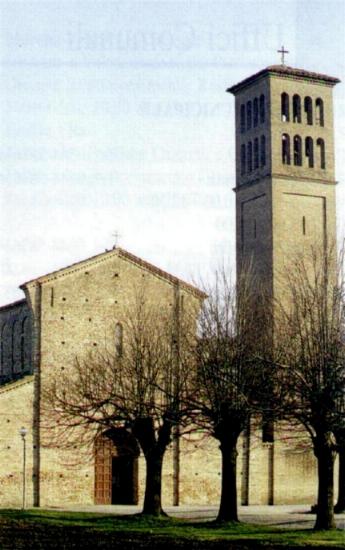 RUSSI
(Ravenna)
RUSSI
(Ravenna)
Monuments and Churchs
THE ROMAN VILLA
The most relevant evidence of the past of Russi in the Roman Villa,
one of the most important roman archeological findings in Northern Italy.
The Villa, built in the first century BC and inhabited un until the
second half of the 4th century, then plundered for its building materials,
in of important interest because of its complete agriculture and productive
development, a two floor residence of the "dominus" (farm owner) anda alarge
production area.
The ground floor mosaics are black and white in elegant and geometrical
designs.
 The
wall plasters, removed and conserved in the National Museum of Ravenna,
are frescoed with animal figures and flower arrangements.
The
wall plasters, removed and conserved in the National Museum of Ravenna,
are frescoed with animal figures and flower arrangements.
A large termal furnace was recently discovered. It served the Villa,
in particular the thermals bath.
Under the Villa two tombs from the 7th and 6th centuries BC have
been found, with vases and various utensils, these also conserved in the
museum of Ravenna.
Others Villas were present in the area, one of these has been discovered
in the nearby village og Godo during excavation works.
The Roman Villa's complex, wich is state-owned, includes a building
used for exhibitions, a hall mainly used for didactic purposes, rooms used
as warehouses and rooms used for restoration.
Villa Romana: via Fiumazzo, 25 - tel. 0544581357
Timetable: summer 9am - 7pm - winter 9am - 4pm
CHIESA ARCIPRETALE
It is dedicated to S. Apollinare. Its construction began in 1785 and
finished in 1788, thanks to the work of dean Stefano Cattano. The construction
plan was mae by architect G. B Campidori from Faenza.
The church abounds with statues made by the famous sculptor Ballanti
- Graziani, from Faenza.
The high altar, wich is made of valuable marble, comes from the
Chiesa delle Monache if the Corpus Domini of Ravenna.
CHIESA DEI SERVI (o dell'ADDOLORATA)
Also known as Chiesa dei Servi, because it belongs to the Ordine dei
Servi di Maria is a gorgeous building dating back to the 18th century.
The construction of this church began in 1766 and it ended many years later.
The original construction plan was by Antonio Farini, but it was
probably revised by Gioacchino Tomba, who was from Faenza. In 1766, he
undertook the task of finishing the construction of the church. The stucco
work is particularly beautiful, especially that of the choir stall.
CHIESA DEL CARMINE
It was built in 1748. It is particularly interesting for its pictures
and decorations by Camporesi di Meldola, who worked in Forlì and
was known ad the "flowers painter".
LA ROCCA (PINACOTECA)
 Two
torrets are the remains of the castle. One of them has a quadrangular base
and overlooks Piazza Farini; the others has a circular base and can be
seen
from via Trieste.
Two
torrets are the remains of the castle. One of them has a quadrangular base
and overlooks Piazza Farini; the others has a circular base and can be
seen
from via Trieste.
Both of them are part of the ospital building . the four turrets
at the corners of the castle still exist today but only two of them
can be seen.: that in the park and that in via E. Babini.
Today, the torrets of the ospital building are residence of a picture-gallery
with works of 17th and 18th century.
PIEVE DI SANTO STEFANO IN TEGURIO
- GODO
The name S. Stefano in Tegurio is probably to be referred to the old
course of the river Tegurio (Montone), which ran near the place where the
church was built. The first document stating its existence dates back to
the year 963. It was rebuilt after World War II and is still very similar
to the original building, expecially in the central nave with rostral pillars
and stone columns ancient capitals.
PIEVE DI SAN PANCRAZIO - SAN PANCRAZIO
 Accordind
to the traditions, the parish was built for Galla Placidia (daugther of
the Emperor Teodosio the great) in the year 437 a.C., but the first document
in which it appears dates back to 963 a.C. According to some studies, it
was built during the 8th or the 9th century.
Accordind
to the traditions, the parish was built for Galla Placidia (daugther of
the Emperor Teodosio the great) in the year 437 a.C., but the first document
in which it appears dates back to 963 a.C. According to some studies, it
was built during the 8th or the 9th century.
It had been on good conditions until 1944 when the war caused the
destruction of part of it (including the apse). It is the oldest medieval
parish of the area and is composed of three naves with rostral pillars.
Although half of it has been rebuilt, it is an important example of ancient
religious achitecture.
Home
page
 RUSSI
(Ravenna)
RUSSI
(Ravenna) RUSSI
(Ravenna)
RUSSI
(Ravenna)